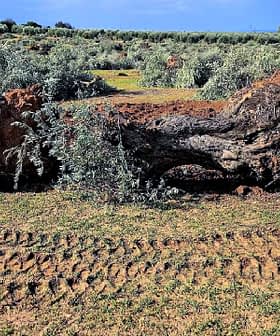Study: Multi-Year Droughts Will Significantly Impact European Agriculture This Century
The study published in Earth’s Future found that the 2018 to 2020 drought in Europe was the worst since 1766, impacting agriculture, the environment, and local populations. Researchers from Germany and the Czech Republic identified this drought as a new benchmark for Europe, highlighting the increasing length and intensity of multi-year drought events and emphasizing the need for global greenhouse gas emissions reduction.
The latest multi-year drought in Europe (from 2018 to 2020) was the worst such event since 1766, according to newly-published research.
The study, published in Earth’s Future, concluded that these droughts are having a profound impact on agriculture, the environment and local populations.
What we have to expect in the future are multi-year droughts of the same intensity as the 2018 to 2020 event but lasting way longer. This greatly depends on how global warming will develop.
The researchers also said that the droughts are increasing in length, often stretching for several consecutive years, and are becoming more intense.
Researchers from the UFZ-Helmholtz Center for Environmental Research in Leipzig, Germany, and the University of Life Sciences in Prague, identified the 2018 to 2020 drought as a new benchmark for Europe.
See Also:Climate CoverageThey said it showed “an unprecedented intensity that persisted for more than two years, exhibiting a mean areal coverage of 35.6 percent and an average duration of 12.2 months.”
According to the scientists, the last European multi-year drought is more relevant than previous events because of the high surface air temperatures reported during its occurrence. The researchers believe that such temperatures add to the evidence that climate change exacerbates drought events.
One of the most relevant characteristics of a multi-year drought event is its impact on vegetation.
“Sometimes, single-year droughts can be sustained by the ecosystem, like a forest,” Oldrich Rakovec, a researcher at the UFZ-Helmholtz Center, told Olive Oil Times. “But when there is extreme stress, as the ecosystem is exposed to the multi-year drought, the effects can be severe on vegetation and forests and their dynamics,”
The scientists’ analysis “is based on characterizing anomalous conditions of root-zone soil moisture that reflect the antecedent and contemporary hydro-meteorologic conditions and constitutes the primary source of water for plant growth.”
While many data have been gathered on single-year and specific drought phenomena across Europe, the new research reported how far fewer significant studies had been conducted on the effects and dynamics of multi-year droughts.
The researchers investigated the 2018 to 2020 drought’s effects on agriculture, finding significant drops in crop yields for the main staple cereals across the European continent: losses of up to 17.5 percent for wheat in Germany, 20 to 40 percent loss of grain maize in western Europe and around 10 percent losses for barley in most countries.
Multi-year droughts also are crucial in understanding climate evolution in a global scenario characterized by growing greenhouse gas emissions and the increasing occurrence of extreme weather events.
“1766 as a starting date for our study is very practical since that is the year our Swiss colleagues started collecting climate data based on temperature and precipitation,” Rakovec said. “That allowed us to build a hydro-meteorological model to peek into past and future tendencies.”
The researchers also mentioned the latest report of the European Commission, which estimates the monetary loss due to drought at €9 billion per annum. The most significant portion of these losses is related to agriculture, followed by the energy sector and the public water supply systems.
“Besides direct financial losses, the natural net ecosystem carbon uptake can be further significantly reduced by drought conditions,” the researchers wrote.
“What we have to expect in the future are multi-year droughts of the same intensity as the 2018 to 2020 event but lasting way longer,” Rakovec added. “This greatly depends on how global warming will develop.”
Given the current uncertainty on the future global greenhouse gas emissions scenario, the researchers based their estimates on the two scenarios used as a common platform for climate models, RCP 4.5 and RCP 8.5.
The former is considered a stabilization scenario that will see greenhouse gas emissions level out and global temperatures rise by about 2.4 ºC compared to the pre-industrial era by 2100. The latter is a worst-case scenario where no special measures are taken to curtail greenhouse gas emissions, and by 2100 temperature could rise by 4.3 ºC.
Using the RCP 4.5 scenario, the most extreme droughts in the current century might last up to 100 months, several times longer than the 2018 to 2020 benchmark drought. In the RCP 8.5 scenario, droughts could last up to 300 months.
“While the moderate RCP 4.5 emission scenario projects the most significant drought clusters to cover up to 50 percent of the entire domain [European continent], this areal extent reaches up to 65 percent based on the high-emission scenarios,” the researchers wrote.
“The scope of our research was to gather and analyze data relative to the whole European continent, not to give suggestions on global mitigation strategies,” Rakovec added. “But, of course, on a personal level, I would stress the relevance of wiser systems of water management and of precision agriculture to truly target the plant when using water for irrigation.”
“On a global scale, the most relevant action I can think of is the reduction of the global greenhouse gas emissions,” he said.
The researchers concluded that the 2018 to 2020 drought event should be considered a wake-up call on agricultural policies in Europe and the rest of the world.
“Multi-year droughts are a global problem,” Rakovec said. “As an example, look at the California drought, a multi-year event which is stretching over 10 years. And that is affecting agriculture and water availability there.”









